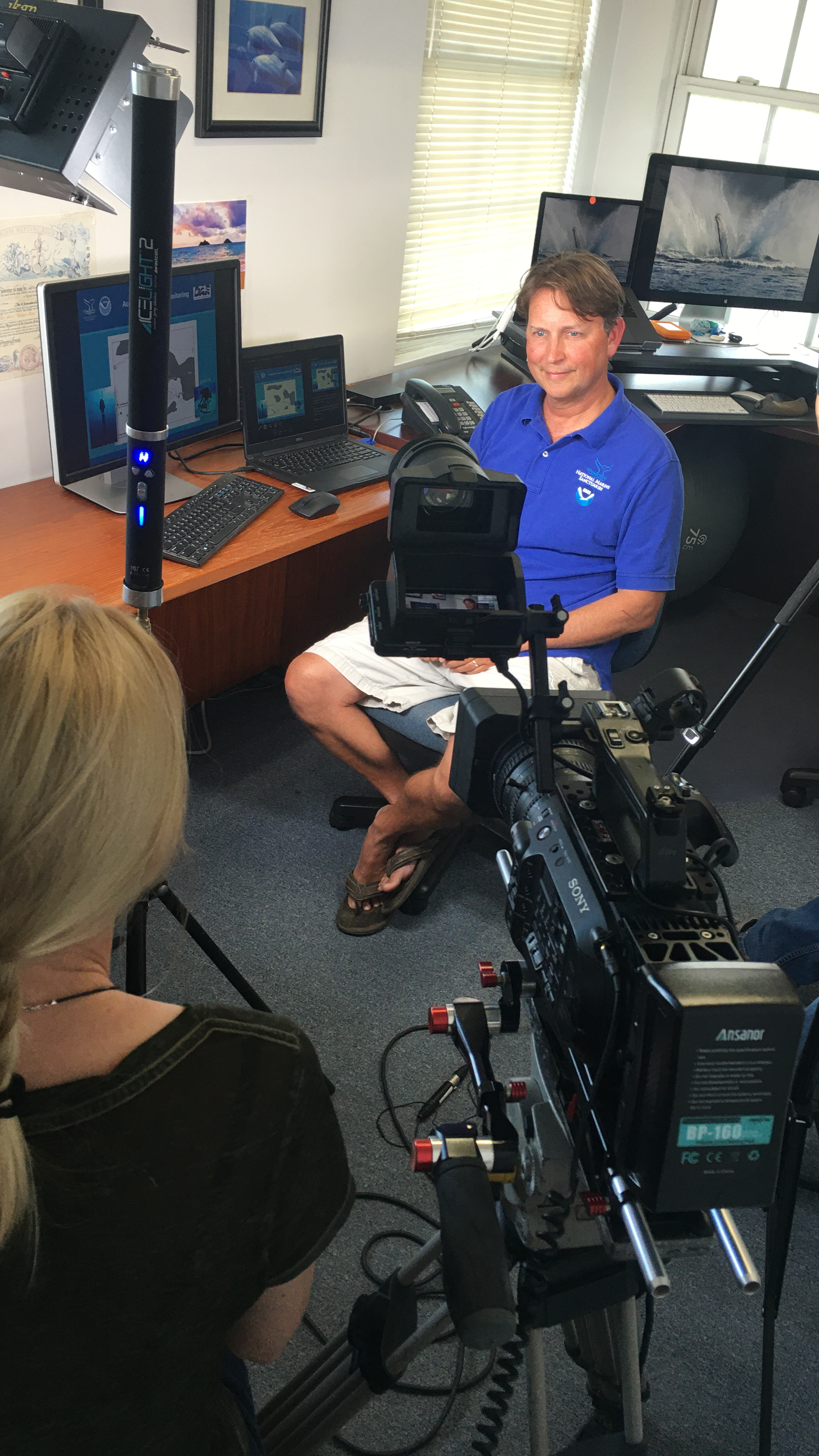Episode Photos
The Hawaiian Islands are the principal breeding grounds for North Pacific humpback whales. During the spring and summer months, the majority of these whales migrate to Southeast Alaska, the Gulf of Alaska, and Northern British Columbia to feed. Image taken under NMFS MMPA/ESA Permit # 19703.
Because Hawai‘i is such an important breeding habitat for North Pacific humpback whales, the Hawaiian Islands Humpback Whale National Marine Sanctuary was created to offer protection for the animals while they are in the relatively shallow waters surrounding the islands.
The sanctuary science team uses a three-pronged approach to determine how many humpbacks visit Hawai‘i each winter. One method consists of regular boat surveys on the leeward side of Maui to count whales along a pre-determined transect line.
The sanctuary's Captain Sara Wood is spotting a whale while Research Specialist Eden Zang is taking detailed notes about the animal's location.
The sanctuary plays a key role in assessing trends in the Hawaiian humpback whale population by conducting research and coordinating communication among stakeholders.
Pride of Maui's Russell Hanson provides boat support to assist in the upkeep of strategically placed acoustic recorders which continuously record sound in the waters around Maui. While on the breeding grounds, the male humpbacks perform elaborate songs, which become the dominant source of sound underwater.
Sanctuary Research Specialist Eden Zang dives to retrieve one of the acoustic recorders so she can download its data and change out the battery.
An acoustic recorder on the seafloor. The sound recorded by the devices helps sanctuary scientists know when whales are in Hawaiian waters, as well as when their numbers are at their peak during the breeding season.
Sanctuary Research Specialist Eden Zang downloads data from an acoustic recorder while Videographer Felipe Marrou gets the shot.
Ph.D. Candidate Anke Kügler (left) and Intern Isabella Canepa (right) look out over Maui's leeward waters, where the humpbacks congregate during the breeding season. Anke regularly counts whales from this elevated shore station as part of the sanctuary's efforts to determine the number of whales in its waters.
Once Anke spots a whale, she uses a surveyor’s instrument called a theodolite to measure the horizontal and vertical angle of its position. This lets her determine the spacial distribution of the humpbacks. Videographers David Diez (left) and Felipe Marrou (right) capture the action while Intern Isabella Canepa records data.
Changing Seas Series Producer Alexa Elliott interviews the sanctuary's Research Ecologist Marc Lammers, Ph.D.
Videographer Felipe Marrou sets up an interview with Adam A. Pack, Ph.D., a longtime whale researcher in Hawai‘i. Adam is a Full Professor at the University of Hawaiʻi at Hilo, and the Co-Creator of the UH Hilo LOHE Bioacoustics Laboratory, as well as the Co-Founder and current President and Director of The Dolphin Institute.
Scientists with the Keiki Kohola Project focus their research on humpback whale mother and calf pairs in Hawaiian waters. Lead Researcher Rachel Cartwright, Ph.D. drives the boat while Vanessa Danielson captures photo ID images of the animals.
Keiki Kohola Project Lead Researcher Rachel Cartwright, Ph.D. scans Maui's waters for humpback whale mother and calf pairs.
A humpback whale calf in the waters off Maui. Image taken under NMFS MMPA/ESA Permit #22750.
From left to right: Videographer Felipe Marrou, Adam A. Pack, Ph.D., Mark Deakos, Ph.D. and Joe Mobley, Ph.D. preparing to count whales as part of an aerial survey.
The team conducted aerial surveys in 2019 and 2020 to estimate the humpback whales’ density. The researchers focused their efforts on the entire Maui Nui region, where humpbacks are known to congregate in the relatively shallow water.
A humpback whale on the feeding grounds in Southeast Alaska. Image taken under NMFS MMPA/ESA Permit #19703.
Scientists with the Alaska Whale Foundation conduct humpback whale research in parts of Southeast Alaska each April through October.
Ph.D. Student Martin van Aswegen (center) with the Marine Mammal Research Program at the University of Hawaiʻi at Mānoa collaborates closely with the Alaska Whale Foundation each summer. Martin collects drone measurements of the humpbacks from the air to better understand changes in their body condition.
Alaska Whale Foundation Graduate Fellow Rhianna Thurber catches the drone after Martin has collected video of humpback whales.
Humpback whales can be found in Alaska during all months of the year, but their numbers drop between November and early April when a majority of the animals migrate to the Hawaiian breeding grounds. Image taken under NMFS MMPA/ESA Permit #19703.
Director of the Marine Mammal Research Program at the University of Hawaiʻi at Mānoa, Lars Bejder Ph.D., catches the drone in Hawaiian waters. Martin also collects measurements of the whales while they are on their breeding grounds.
Martin van Aswegen (front) collecting whale measurements in Hawaiian waters, while Lars Bejder, Ph.D. captures photo ID images.
North Pacific humpback whales migrate some 2500-3000 miles between their Hawaiian breeding grounds and their Alaskan feeding grounds. Image taken under NMFS MMPA/ESA Permit #19703.
NOAA Fisheries Research Fisheries Biologist John Moran explains how humpbacks use their baleen to filter feed.
Scientists can identify individual humpback whales by their unique black and white pigmentation patterns and the shape of the trailing edge of their flukes. Image taken under NMFS MMPA/ESA Permit #19703.







































